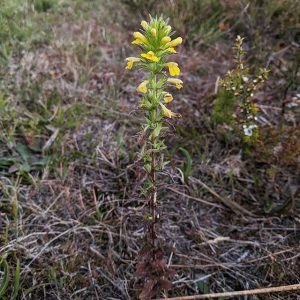Yellow Glandweed (Bellardia viscosa), a hemi-parasitic European broomrape spread to Australia in the late 19th century in contaminated grass seed.
The species colonises paddocks, along with roadsides and tracks subject to recurring disturbance, but it can also invade rock outcrops, heathlands and open woodland. Although adapted to parasitise the root systems of exotic grasses and herbaceous weeds (eg. cultivated Poas, Trefoils, and Eurasian weed asters), it has been found in WA to also capably exploit indigenous vegetation of similar types.
Covered in glandular hairs, and so also called Tarweed, or Sticky Bartsia in reference to an older assignation, due to ongoing taxonomic revision in Lamiales the species is known in many jurisdictions as Parentucellia viscosa.
Introduced to New Zealand by 1875, the first collections in Australia were made in Victoria at Port Albert (1882) and Muddy Creek (1888) in Gippsland. By 1906 it had been spread or separately introduced to the western part of the state (on the Gellibrand River); and it showed up in the Yarra Ranges in 1919. A 1924 report that ran in the Camperdown Chronicle described the effect of Yellow Glandweed on infested pastures: ‘During the past spring several paddocks in the neighbourhood of Swan Marsh presented a remarkable scene: scarcely anything could be seen but a waving mass of golden yellow flowers.’
The species was also introduced to Tasmania, SA, WA and NSW. Promotional efforts spruiking superphosphates for grazing land in the early part of the 20th century sometimes cited their assistance in minimising the impact of this paddock weed by assisting the growth of desired grasses and forbs.
The photographed plants were found growing on a fire track in coastal heath east of Cape Otway. Occurring frequently in cool and damp parts of Victoria, in the metropolitan the species is found principally along the Dandenong edges and down into Frankston and Cranbourne, with scattered records at Laverton, Campbellfield and Mullum Mullum Creek.
View Original Post on Instagram
Search for information about Bellardia viscosa in the Flora of Victoria
View information and occurrences of Bellardia viscosa on the Atlas of Living Australia











